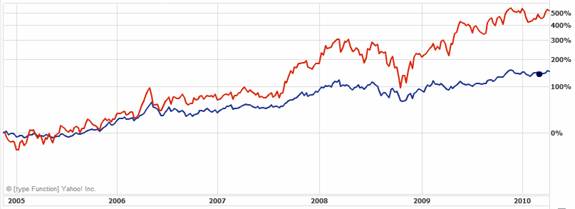- Are
You Bearish on Gold? - Three
Times Better than GLD - An
investment that multiplies gold’s gains
If you’ve been a reader for very long, you might have
noticed that I’m not a huge fan of the exchange traded fund Spidershares Gold
Trust (NYSE: GLD). Each share of this
ETF corresponds to 1/10 of an ounce of gold, kept in the fund’s vault in
I should point out up front: I’m both long-term and
short-term bullish on gold prices. I
think as long as governments around the world treat their currencies like their
own private piggy banks to inflate at will, gold will remain a good place to
put your money.
So why don’t I like GLD? I’ve glossed over these reasons before, but I think you deserve the benefit
of some research and facts before you put my theories into practice in your own
portfolio.
bullish on gold. If you’re not bullish
on gold, please PLEASE drop me an email at [email protected]
and tell me why.
30th issue of the Resource Prospector:
“As someone who personally owns physical
gold, I can’t understand why gold investors would be interested in owning GLD.
It offers none of the benefits of owning physical gold, and none of the upside
of buying a gold security.
Having physical gold in your possession is a
security blanket; it protects your bottom dollars from the eventuality of a
currency crisis. But having it in a vault in
Buying a gold security, like a junior miner,
explorer, royalty trust or refiner gives you the potential to multiply gains
made in the price of gold. But GLD only barely keeps pace. It will never
multiply gains made in gold unless you want to trade GLD options.”
So I made some pretty big claims for traditional gold
securities, but where’s the proof?
I’ve plotted GLD’s chart right alongside the chart of one of the gold holdings
in the Global Commodity
Investing portfolio.
it’s gone up about 150%. That’s not
bad. But look at what happened to the
gold stock:

Our gold stock rose more than 500% during the same
period that GLD only went up 150%.
capital gains in GLD are taxed like physical gold: as a collectible. That means a 28% ding on your gains instead
of the 15% tax on long term stock gains.
physical stuff and put it somewhere safe – and close at hand. Buy from a reputable vendor that offers a
buy-back guarantee. I’ve used both Blanchards
and kitco. I have no affiliation with these vendors – I’ve just bought products
from both of them, and have been satisfied with their service.
by buying physical gold.
The reason we buy gold is for security. We can only realistically hope that gold will stay one step ahead of
inflation.
But if you want to get rich investing because you
believe in higher gold prices, you should buy a gold security with the chance
to multiply gains in gold.
to multiply gold’s gains for a simple reason: mining gold is extremely
difficult, so these companies can typically buy land for much, much less than
the value of the gold in the ground.
of gold in it. If our gold company
bought that land 15 years ago in 1995 when gold was $400/oz, that’s $40,000
worth of gold in the ground. But our
gold company is smart and patient, while the landowner just wants cash. So our company will offer the landowner
$10,000 for the land. The average gold
mine takes close to 10 years to start producing gold, and they can’t get all
the gold out at once. It’s a long, slow
process to get all the gold out.
it will take another 10 years before the mine is completely tapped.
prices were about $425 an ounce. Since
then, as we know, gold prices have skyrocketed. So every year, this company becomes more profitable. By 2008, when gold prices broke $1000/oz, they’ve
made all of the initial $10,000 outlay back, and then some. And every increase in gold’s price is pure
profit.
they’re producing over $11,000 in gold every year. Every year they get richer by the value of
their initial cash-in-hand.
good idea of how gold stocks can multiply your investment.
stocks. GLD just can’t compete.
chart, but it wouldn’t be fair to Global Commodity Investing’s paid
subscribers. What I can do, is let you
take a trial subscription to this service. You’ll have 30 days to check out back-issues, special reports and our
current portfolio, including the gold stock I’ve been mentioning. Just click here to get full
access. If, after 30 days you decide
that Global
Commodity Investing isn’t for you, just let us know and we’ll give you
a full refund.
Editor
Resource Prospector
 Facebook
Facebook
 Twitter
Twitter